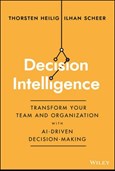- Innovation
Decisions, Decisions, in the AI Era
A timely guide to balancing AI with human intuition to make better leadership decisions
“Two roads diverged in a wood and I took the one less traveled by, and that made all the difference." Robert Frost
To automate decision-making dependably, with help from AI and machine learning, leaders need to understand when, where, and how to augment human judgement.
Adapting to any new technology can be problematic. With AI’s profound nature, and the speed in which it has become involved in so much business activity, business leaders can be very confused even lost. Nowhere is this more critical than in the case of AI-driven decision-making. Many AI tools are now available but there are few recognized guides to the effective use of these technologies in assisting this fundamental leadership function.

In their new book, Decision Intelligence: Transform Your Team and Organization with AI-Driven Decision-Making, Thorsten Heilig and Ilhan Scheer aim to put this right. The book opens with an analysis of decision-making (good and bad), its evolving history, and how traditional decision-making is now broken. It then looks at the impact of 21st century data-based technologies on decision-making.
It shows how data analysis, business intelligence, and process mining techniques are unable to keep up with today’s new reality. The authors argue that using these practices, that are reliant on monitoring historical and near real-time data, to address business challenges, is like driving with only a view into the rear-view mirror. This process, they suggest, should only be the first step in making a data supported decision. Here they introduce the idea of decision intelligence—the means by which leaders should actually engage with and use data to enhance their decisions.
Central to decision intelligence is intuition. Not intuition in the old sense of ‘gut feeling,’ but, as the authors describe, “a professionally trained and used intuition that helps us beyond a rational understanding.” A powerful dynamic and adaptable force that enables us to read patterns and manage complexity. Here is where AI and machine learning models based on new generation neural networks can work in combination with humans, allowing faster analysis of even very large and complex data sets to support human judgement.
This presents an optimistic view of the future of decision-making. Even as AI and machine learning algorithms become increasingly capable of processing vast amounts of data and offering ever more precise and sophisticated predictions and advice, the human component, in the form of highly trained skills of intuition, will remain essential; the human input bringing, diverse perspectives, creativity, and emotional intelligence to decisions—not to mention an essential moral and ethical overview.
However, getting to this idyllic future where machines and humans work together seamlessly in an organizational or even a team context will not be all plain sailing. Besides the need to define and develop the necessary skills of intuition there are numerous difficult issues to be faced before achieving a smooth implementation of decision intelligence and AI-driven decision-making. Heilig and Scheer address a series of potential difficulties in the second half of the book. Data quality is key. It is important to make relevant information visible and aggregated across the organization, avoiding silos, and to eliminate potential biases in the data. Building the best AI systems for decision making is another priority.
Another hurdle involves organizational culture. Creating the right organizational structure, purpose and environment is key to enabling data-driven decision-making to thrive. Organizations should be open to feedback and to considering different perspectives. Courage, trust, transparency, experimentation, psychological safety, and acceptance of failure are all important factors. As too are technical skills—the authors discuss the need for “a symphony of skills.” There must also be a fundamental commitment to consulting and constantly using quality relevant data to inform discussions and underpin decisions across the organization. Elaborating on this, the authors suggest four Rs of decision intelligence: rhythm in the organization’s workflow; rigor, what is agreed is agreed; reflection and continuous learning; and recovery time to rest and regroup.
The results of effective decision-making should not be solutions but actions, say Heilig and Scheer. Their book provides many reasons, incentives, and directions for action.
………………………………………………………………………………………………………………………
ARTICLES YOU MIGHT LIKE
VIEWPOINT
Cognitive neuroscientist, Lynda Shaw, explains how to understand and support intrapreneurs
DEVELOPING LEADERS QUARTERLY MAGAZINE AND WEEKLY BRIEFING EMAILS

































